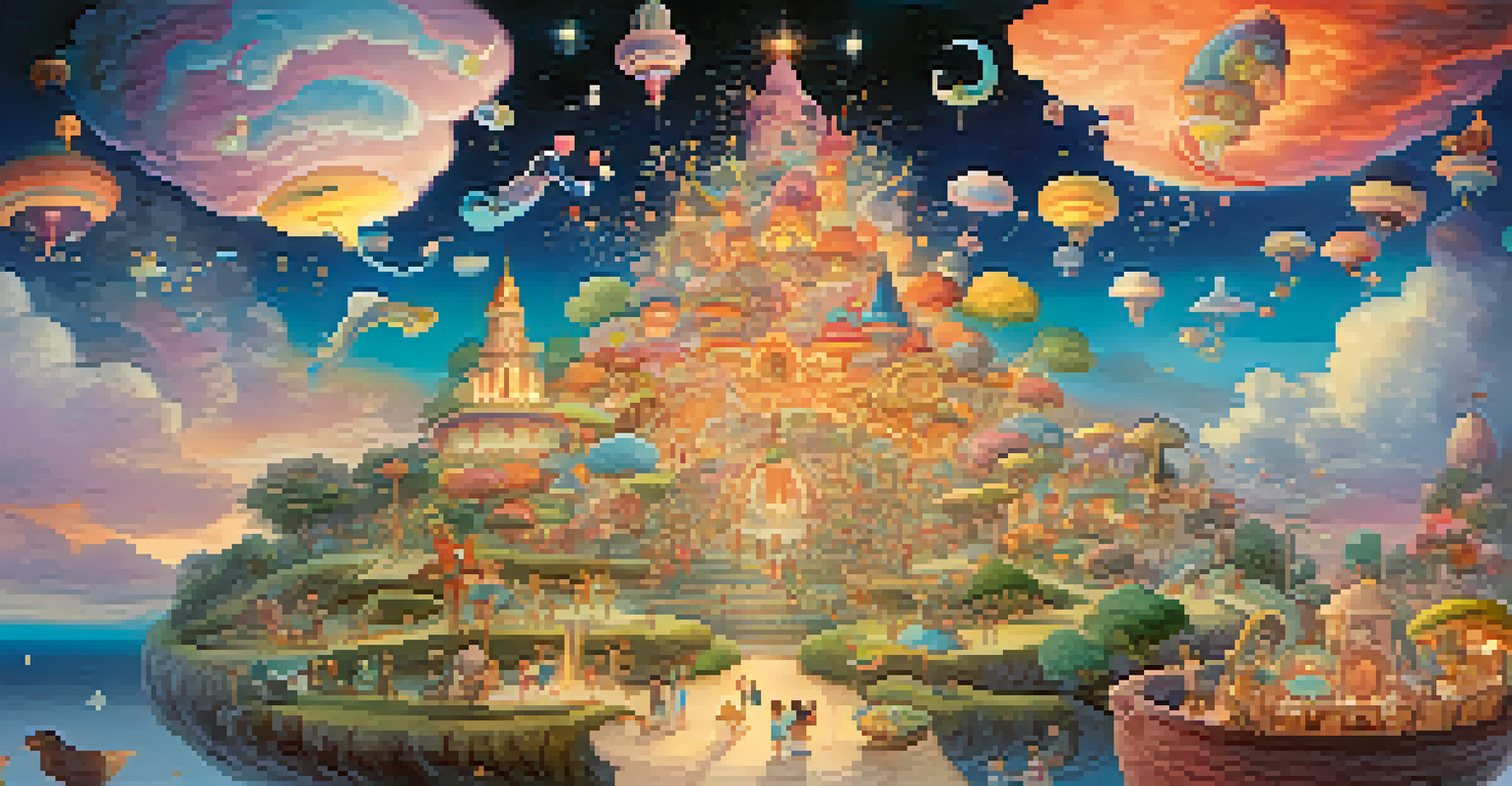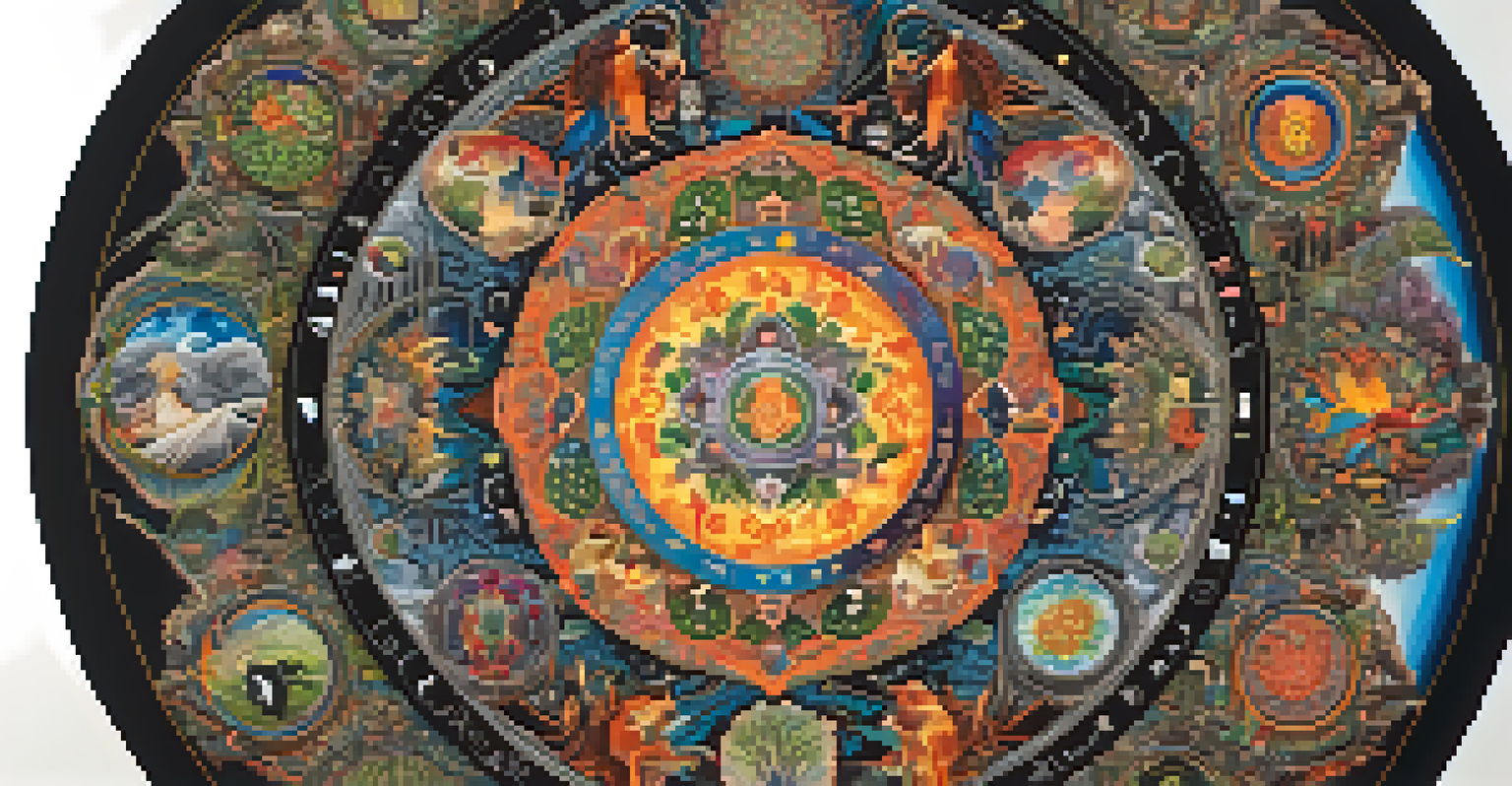Depicting the Afterlife: Religious Interpretations in Film

The Afterlife: A Universal Theme in Cinema
From the dawn of storytelling, the afterlife has intrigued humanity, and film is no exception. Movies often explore what happens after we die, reflecting our deepest fears and hopes. This universal theme resonates with audiences, prompting filmmakers to delve into different interpretations rooted in various religious beliefs.
Death is nature's way of telling you to slow down.
These interpretations not only entertain but also provoke thought about our own beliefs and experiences. They invite viewers to consider questions about existence, morality, and the consequences of our actions. By framing the afterlife through cinematic narratives, filmmakers can engage audiences in profound discussions about life, death, and everything in between.
For instance, films like 'The Sixth Sense' and 'What Dreams May Come' present unique visions of the afterlife that challenge traditional religious views. Through these narratives, we can see how film serves as a mirror reflecting society's evolving understanding of life after death.
Christianity and the Afterlife in Film
Christianity often portrays the afterlife as a dichotomy between heaven and hell, a theme frequently explored in films. Movies such as 'Heaven Is for Real' and 'The Passion of the Christ' emphasize faith, redemption, and the hope of eternal life. These narratives offer viewers a glimpse into the Christian understanding of salvation and the consequences of sin.

The imagery of heaven as a paradise and hell as punishment resonates deeply, providing a moral framework for audiences. Such films often incorporate biblical references, reinforcing the teachings of Christianity while making them accessible to a broader audience. This can lead to discussions about faith, forgiveness, and the human condition.
Afterlife Themes in Cinema
Films explore various interpretations of the afterlife, reflecting cultural beliefs and provoking deep existential questions.
Moreover, the portrayal of angels, demons, and divine interventions in these films highlights the spiritual battles that many believe occur in the afterlife. These representations can inspire viewers to reflect on their own beliefs and the role of faith in their lives.
Buddhism and Reincarnation in Cinematic Narratives
Buddhism offers a vastly different perspective on the afterlife, focusing on the cycle of reincarnation. Films such as 'The Fountain' and 'What Dreams May Come' incorporate elements of Buddhist philosophy, illustrating the idea of rebirth and the quest for enlightenment. These narratives challenge the Western notion of a linear afterlife, inviting viewers to ponder the cyclical nature of existence.
The fear of death follows from the fear of life. A man who lives fully is prepared to die at any time.
The concept of karma plays a significant role in these films, emphasizing that our actions in this life shape our future existences. This moral accountability resonates with audiences, encouraging them to lead ethical lives. By exploring these themes, filmmakers provide a platform for viewers to engage with Buddhist teachings in a meaningful way.
Additionally, these narratives often highlight the importance of mindfulness and living in the present. This approach can inspire viewers to seek spiritual growth and understanding beyond the confines of traditional religious structures.
Hinduism: The Cosmic Dance of Life and Death in Film
Hinduism’s rich tapestry of beliefs surrounding the afterlife is often depicted in film, showcasing the intricate dance of life, death, and rebirth. Movies like 'Karma' and 'Om Shanti Om' explore themes of reincarnation and the influence of past lives on current circumstances. This narrative framework encourages audiences to consider their own actions and the impact they have on their spiritual journey.
The portrayal of deities and the concept of moksha, or liberation from the cycle of rebirth, add depth to these stories. This quest for enlightenment can resonate with viewers, prompting them to reflect on their personal beliefs and the pursuit of spiritual fulfillment. Such films often present a vivid visual representation of Hindu cosmology, making complex ideas more accessible.
Religious Perspectives on Afterlife
Different religions portray the afterlife uniquely, with Christianity, Buddhism, Hinduism, and Islam offering distinct narratives that encourage reflection on morality and existence.
By integrating elements of Hindu philosophy into mainstream cinema, filmmakers can bridge cultural gaps and foster understanding. This not only enriches the viewing experience but also encourages cross-cultural discussions about spirituality and the afterlife.
Islamic Views of the Afterlife in Film
Islam presents a unique interpretation of the afterlife, often depicted through the lens of divine judgment and the concepts of paradise (Jannah) and hell (Jahannam). Films like 'The Message' and 'Bilal: A New Breed of Hero' explore these themes, illustrating the importance of faith, righteousness, and the consequences of one's actions. Such narratives invite viewers to contemplate the moral implications of their choices in life.
The portrayal of paradise as a place of beauty and tranquility offers a comforting vision for many viewers. This depiction encourages a sense of hope and purpose, aligning with Islamic teachings about striving for a life that pleases God. The contrasting imagery of hell serves as a stark reminder of the potential consequences of a life lived in disobedience.
Furthermore, these films often highlight the importance of community and the shared journey of faith. By depicting characters grappling with their beliefs and striving for spiritual growth, filmmakers can foster empathy and understanding among audiences of different backgrounds.
Secular Perspectives on the Afterlife in Cinema
Not all films approach the afterlife from a religious standpoint; many adopt secular perspectives that resonate with a broader audience. Movies like 'The Others' and 'A Ghost Story' explore themes of existence and the legacy we leave behind, often delving into the emotional aftermath of loss. These narratives encourage viewers to reflect on their own lives and relationships, regardless of their religious beliefs.
Secular interpretations of the afterlife can also challenge traditional views, prompting audiences to question the very nature of existence. By presenting alternative realities and existential dilemmas, filmmakers invite viewers to consider what it means to be human. This exploration of life, death, and everything in between can be both thought-provoking and cathartic.
Animation's Unique Afterlife View
Animated films such as 'Coco' and 'Soul' creatively depict the afterlife, making complex ideas accessible while celebrating diverse cultural beliefs.
Moreover, these films often emphasize the significance of memory and how our experiences shape our understanding of life after death. This focus on personal narratives allows for a more nuanced exploration of the afterlife that transcends religious boundaries.
The Role of Animation in Representing the Afterlife
Animation provides a unique medium for depicting the afterlife, allowing for imaginative and visually stunning interpretations. Films like 'Coco' and 'Soul' explore themes of memory, legacy, and the connections we share with loved ones who have passed away. These animated narratives resonate with audiences of all ages, offering both entertainment and deep emotional insights.
Through vibrant visuals and engaging storytelling, animated films can make complex ideas about the afterlife more accessible. They often incorporate cultural elements, providing a rich tapestry of beliefs that celebrate diversity. This approach encourages viewers to appreciate the myriad ways different cultures conceptualize life after death.

Moreover, animation allows for playful yet profound explorations of the afterlife, often blending humor with poignant moments. This balance can make discussions about death less daunting, fostering a sense of comfort and understanding among viewers.